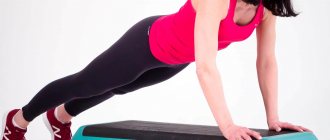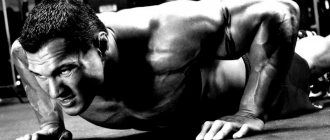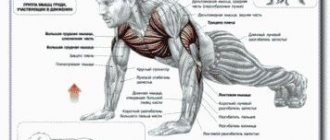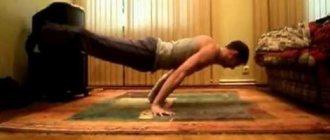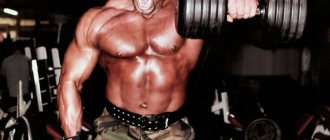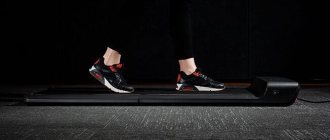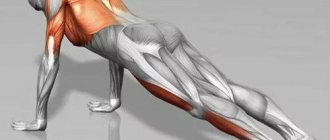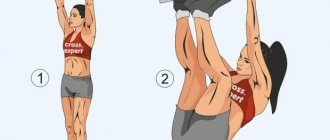Research¹ into the biomechanics of push-ups shows that the exercise activates the same muscle groups as the bench press, one of the five compound exercises. Moreover, the load falls not only on the chest, but also on the muscles of the triceps, shoulders, trapezius and core.
At the same time, the contribution of the triceps to the weight-squeezing phase is up to 60% of the work of the pectoral muscles - while beginners (and, especially, girls) only partially activate the triceps in push-ups. This limits the range of motion and reduces the effectiveness of the exercise.
Content
- The benefits of push-ups
- How to do push-ups correctly: step-by-step technique
- Breathing rules for push-ups
- Basic mistakes when performing push-ups
- Description of different variations of push-ups from the knees
- With hands resting on the bench
- With your feet resting on the bench
- With a narrow hand position
- With arms wide
- Circular
- Different names
- On one hand
- On fists
- On fingers
Fifth block
We perform the following push-ups on the TRX simulator. These exercises will develop coordination, balance and stabilizer muscles. All push-ups are done with the legs locked in loops.
- Classic push-ups.
The lower back should not bend when performing. - Push-ups with knee to elbow.
After doing push-ups, you need to alternately bend your left and then your right knee, pulling it towards your hand. - Push-ups with legs pulled to chest.
This exercise also pumps up the abdominal muscles. - Jumping handstand push-ups.
The important thing here is to maintain balance and land gently on your palm. - Handstand push-ups with clap.
A more complicated version of jumping push-ups will require skill.
Photo: istockphoto.com
The benefits of push-ups
Push-ups develop strength and stimulate the growth of muscle mass in the shoulder girdle, which is why they are included in the training plan of weightlifters, powerlifters and bodybuilders. The exercise increases endurance, helps to increase the speed of impact, and therefore is included in the training of martial artists.
With the correct technique for performing push-ups, almost all muscle groups are involved:
- large pecs;
- anterior serrated;
- triceps and biceps;
- elbows;
- intercostal;
- deltoid;
- abdominals and back;
- gluteus maximus;
- calf.
How many push-ups should you do?
To the question of what number of push-ups you should strive for, the answer is that for women it is enough to do 40 push-ups, and for men - 100. It is quite possible to obtain these results in one and a half to two months of regular training at home for 15 minutes.
Carefully monitor the technique of performing push-ups, the most important thing is good amplitude. This way the result will come faster.
How to do push-ups correctly: step-by-step technique
- Take a prone position (lie face down on the floor, place your hands slightly wider than your shoulders). Give your body the correct position for push-ups - a straight line shape. The shoulders should be slightly higher than the level of the pelvis. The head should look towards the floor.
- Palms are on the vertical of the shoulders, parallel to each other, the direction of the fingers is parallel to the body. The correct positioning of the hands for classic push-ups is shoulder-width apart or slightly wider.
- Arms are bent, elbows pointing out to the sides at an angle of 45 degrees from the body, fingers pointing forward
- The position of the feet is not fundamental: they can be brought together or apart.
- Gently bend your elbows, slowly lower yourself down, and then rise back up.
- The lowest point is when the right angle between the biceps and forearm is reached. The chest touches the floor.
- In the upper position, the arms are not fully straightened so as not to block the elbow joint. Pause at the top point.
- To increase the effectiveness of the exercise and prevent traumatic axial load on the spine, tighten your abdominal muscles.
Sorry, your browser does not support video viewing.
Breathing rules for push-ups
Inhale as you move down. Move up while exhaling. If you're having trouble maintaining a normal breathing rhythm, you're probably doing push-ups too fast. Reduce the speed of the exercise, move more smoothly, stopping at the top point of the amplitude.
The second reason for shortness of breath during push-ups is smoking. After getting rid of a bad habit, breathing during training returns to normal.
Incorrect breathing technique during push-ups often contributes to increased blood and intracranial pressure.
Basic mistakes when performing push-ups
Not only beginners, but also experienced athletes often do push-ups incorrectly. Not only do they not train effectively, but they also increase the risk of injury.
Back arching significantly increases the axial load on the spine and can cause injury. If it is difficult for you to keep your back strictly straight during push-ups, first pump up your spinal extensors and abdominal muscles.
Putting your arms too wide or pushing your elbows out to the sides
greatly increases the load on the elbow and shoulder joints and ligaments and can provoke injury.
Incomplete range of motion
. The correct position of the hands when pushing up from the floor is when at the lowest point they are bent at an angle of 90°.
Otherwise, the exercise is not effective. If this is difficult for you due to insufficient physical training, experts recommend doing either a lighter version of push-ups, or temporarily replacing the exercise with another.
Do not lift your pelvis higher than your shoulders and do not round your cervical spine.
Description of different variations of push-ups
Push-ups with different hand positions allow you to shift the emphasis to different muscle groups.
From my knees
A lighter version of the classic exercise. Suitable for beginners. Protects the lumbar spine from overexertion and injury.
The starting position is the same as in the classic exercise, only your knees are on the floor (do not lift your shins up, otherwise your back will bend in the lower back). The body is elongated in a straight line from the knees to the top of the head. The pelvis does not rise.
The technique is similar to the classic one.
With hands resting on the bench
A lighter version of the classic exercise. Suitable for beginners. Helps work the lower pectoral muscles.
The starting position is the same as in the classic exercise, only the palms rest on a bench 40-60 cm high. The body is extended in a straight line from the knees to the top of the head. The pelvis does not rise.
The technique is similar to the classic one.
With your feet resting on the bench
Helps work the upper pectoral muscles.
The starting position is the same as in the classic exercise, only the feet rest on a bench 40-60 cm high. The body is extended in a straight line from the knees to the top of the head. The pelvis does not rise.
The technique is similar to the classic one.
With a narrow hand position
For a thorough workout of the triceps.
The starting position is similar to the classic one, only with your palms waist-width apart. Feet hip-width apart.
Technique: while inhaling, bend your arms to a right angle, move your elbows back and press your forearms to your body. As you exhale, return to the starting position.
With arms wide
For a thorough workout of the pectoral muscles.
The starting position is similar to the classic one, only the palms are 2 times wider than the shoulders and turned outward.
Execution technique: while inhaling, bend your arms to a right angle. As you exhale, return to the starting position.
Circular
For a thorough workout of the back and abdominal muscles, increased load on the triceps, deltoids and pectoral muscles.
The starting position is the same as in the classic version.
Execution technique: while inhaling, bend your arms, moving the load to one of them. As you exhale, return to the starting position. Repeat with shifting the load to the other arm.
Different names
For alternately working the pectoral muscles and triceps.
The starting position is similar to the classic one, only the right hand is moved to the side and the left is back.
Execution technique: while inhaling, bend your arms and touch your chest to the floor. Return to the starting position. Repeat, changing the position of your hands.
On one hand
To increase workload.
Starting position - emphasis on the feet and one hand. The width of the feet is slightly wider than the shoulders. The second hand is behind the back.
Execution technique: while inhaling, bend your arm to a right angle. As you exhale, return to the starting position. Change your supporting hand and repeat the exercise.
On fists
For staging strikes in martial arts. Strengthens the articular-ligamentous apparatus of the hand, stabilizes and hardens the striking surface of the fists. Reduces pain sensitivity, develops endurance and muscle strength. Trains balance. Allows you to work in increased amplitude.
Starting position: lying on the floor. The emphasis of the fists is on the index and middle fingers, partially on the ring finger. You can rest your toes against the wall to prevent slipping. At the initial stages, it is possible to focus on the knees, use mats, rugs and other soft surfaces.
Execution technique: while exhaling, forcefully push yourself upward. In the upper position, the body is extended in a straight line. As you inhale, return to the starting position.
On fingers
For a thorough study of the ligaments and muscles of the forearms, hands and fingers. Helps perform strong grips and painful holds. Useful for people who work at a keyboard.
Starting position - arms straight, emphasis on fingers (depending on the level of training - all 5 or less). At the initial stages, emphasis on the knees is possible.
Execution technique: while inhaling, bend your arms, lower yourself down, touch your chest to the floor. As you inhale, return to the starting position.
Classic
To perform this type of push-up, it is important to take the correct position and follow the recommendations in the description.
Here are the main features of this exercise:
- Take an emphasis lying on the floor. In this case, it is important to ensure that the support is on the toes and palms of the hands.
- It is important to place your hands wider on the floor, extending beyond shoulder level.
Now you should raise and lower your body, trying to keep it at floor level. This type of push-up has been known to almost everyone since school days, since it is an integral element of the physical education program.
Push-up program from scratch for beginners
We present a working scheme that helps you reach 100 repetitions per set from one repetition per set. The program is designed for 12 weeks. In the first weeks, the body does not experience heavy stress. This allows beginners to strengthen their muscles. Pause between sets for 1 to 3 minutes. Pauses between sets of 1-2 minutes are necessary to normalize breathing and restore ATP reserves in muscle cells. This push-up program also promotes muscle growth.
The main thing is to perform the presses efficiently, and not quickly. If you cannot complete an exercise, give yourself a break of 1-2 days and do it again. If you do more than one push-up, start with as many push-ups as you can do.
| Mon | Tue | Wed | Thu | Fri | Sat | Sun | |
| Week 1 | 5×1 | 5×1 | Break | 4×2 | 4×2 | Break | 4×3 |
| Week 2 | 5×2 | 5×2 | Break | 4×3 | 4×3 | Break | 4×4 |
| Week 3 | 4×5 | 4×6 | 4×6 | Break | 3×8 | 3×9 | 3×10 |
| Week 4 | Break | 2×12 | Break | 3×10 | Break | 4×8 | Break |
| Week 5 | 2×15 | 2×16 | Break | 3×15 | 3×15 | Break | 4×10 |
| Week 6 | 2×20 | 2×22 | Break | 3×20 | 3×20 | Break | 2×25 |
| Week 7 | 4×18 | 4×20 | Break | 2×38 | 2×40 | Break | 3×30 |
| Week 8 | Break | 3×55 | Break | 4×30 | Break | 5×25 | Break |
| Week 9 | 2×45 | 3×45 | Break | 2×50 | 3×50 | Break | 2×60 |
| Week 10 | 3×55 | 4×50 | Break | 3×60 | Break | 2×65 | 3×65 |
| Week 11 | 2×70 | 4×65 | 2×80 | Break | 2×80 | 3×75 | 2×85 |
| Week 12 | Break | 2×90 | Break | 2×95 | Break | 3×90 | 1×100 |
In three months you will be able to do 100 push-ups in one set. After this, you can move on to more complex programs, or keep yourself in shape by going through the exercises of the last two weeks again.
A little motivation
The strongest motivation is the example of your neighbor. If a girl, for example, does more push-ups than her boyfriend, this is already motivation for the guy! They both end up doing push-ups.
If you want to pump up or strengthen your arms, shoulders, chest, but you can’t go to the gym, here’s a good reason to figure out how to learn to do push-ups.
Set yourself a specific goal for the number of repetitions at a time. The goal will not let you stop or go astray. But without a goal, you will give up training in a week or month.
Use push-up variations for beginners to pre-strengthen your muscles, exercise regularly and with pleasure. In this case, the result will not take long to arrive!
Contraindications for push-ups
- Push-ups should not be done if you have chronic joint diseases - arthritis, arthrosis, bursitis - so as not to cause their exacerbations.
- For chronic diseases of the respiratory tract, heart and blood vessels.
- Since the axial load on the spine increases during the exercise, athletes with protrusions and hernias should include it in the training program only with the permission of the coach or sports doctor.
- People who are overweight should refrain from doing push-ups until their body weight normalizes - their joints will not be able to withstand such a load.
- For injured joints and muscle strains, you should also refrain from exercise until recovery.
Before starting training, it is recommended to be examined by a doctor.
